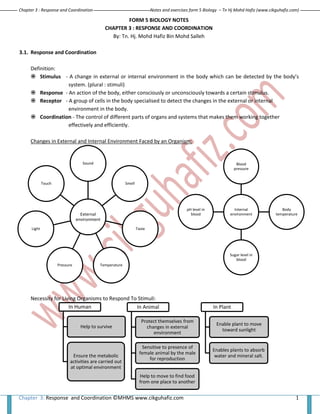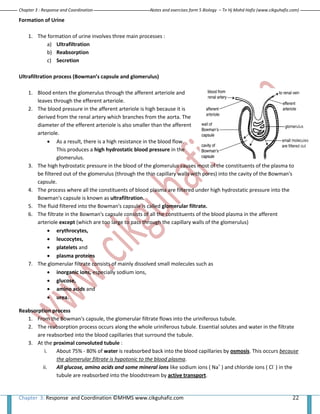The document discusses the human nervous system and its role in response and coordination. It describes:
1) The human nervous system collects information from internal and external stimuli, transmits it to processing centers in the brain and spinal cord, coordinates responses, and maintains homeostasis.
2) The brain is divided into the cerebrum, cerebellum, and brain stem. The cerebrum controls voluntary movement and complex cognitive functions while the cerebellum controls movement coordination and balance.
3) Neurons are the basic functional units of the nervous system, connecting the brain to receptors and effectors via electrically signaling axons surrounded by a myelin sheath for fast transmission.



![Chapter 3 : Response and Coordination Notes and exercises form 5 Biology – Tn Hj Mohd Hafiz (www.cikguhafiz.com)
Chapter 3: Response and Coordination ©MHMS www.cikguhafiz.com 4
PERIPHERAL NERVOUS SYSTEM
Cranial nerves - Send nerve impulse to and from the brain.
- Smell, vision, hearing, movement of eyeball and movement of head and shoulder.
Spinal nerves - Send nerves to and from the spinal cord.
- Contain sensory neurons and motor neurons.
Structure and Function of Brain
1. The brain consists of three main parts :
a) Cerebrum
b) Cerebellum
c) Brain Stem (Medula Oblongota)
1. Below the centre of the cerebrum is the thalamus,
hypothalamus and pituitary gland.
2. The brain is made up of nerve cells called neurones.
3. The outer part of the brain consists of the grey matter
[cerebral cortex] ( which contains the cell body of the
neurone ) and the inner part consists of the white
matter ( which contains the fibres of the neurone ).
Cerebrum
1. The cerebrum is the largest and most complex part of the
brain.
2. It is divided into two halves called the cerebral hemispheres.
3. The left hemisphere controls the movements on the right
side of the body.
4. The right hemisphere controls the movements on the left
side of the body.
5. The cerebral hemisphere is divided into regions containing
specialised groups of nerve cells responsible for sensory,
motor and association functions.
6. The interrelationship between these three areas enables the
cerebrum to control and coordinate all voluntary activities of the body, including highly-developed
functions such as memory, reasoning, learning and speech.
7. Cerebrum control: Learning, Memorising , Speech, Mathematical skill, Imagination, reasoning, Planning,
Touch, Taste, Temperature, Movement, Sight, Hearing, Memory retrieval .
Hypothalamus
1. Located on the ventral region of the cerebrum.
2. Pituitary gland is located at the end of the hypothalamus.
3. Hypothalamus has the richest blood supply in the brain.
4. It acts as a major coordinating centre for regulating: sleep, hunger,
thirst, body temperature, water balance and blood pressure.
5. For example, it detects changes in blood temperature and osmotic
pressure. If there are any changes, it will initiate nerve impulses to](https://image.slidesharecdn.com/form-205-20biology-20notes-20-chapter-203-130522100419-phpapp02/85/Form-5-biology-notes-chapter-3-Coordination-4-320.jpg)























